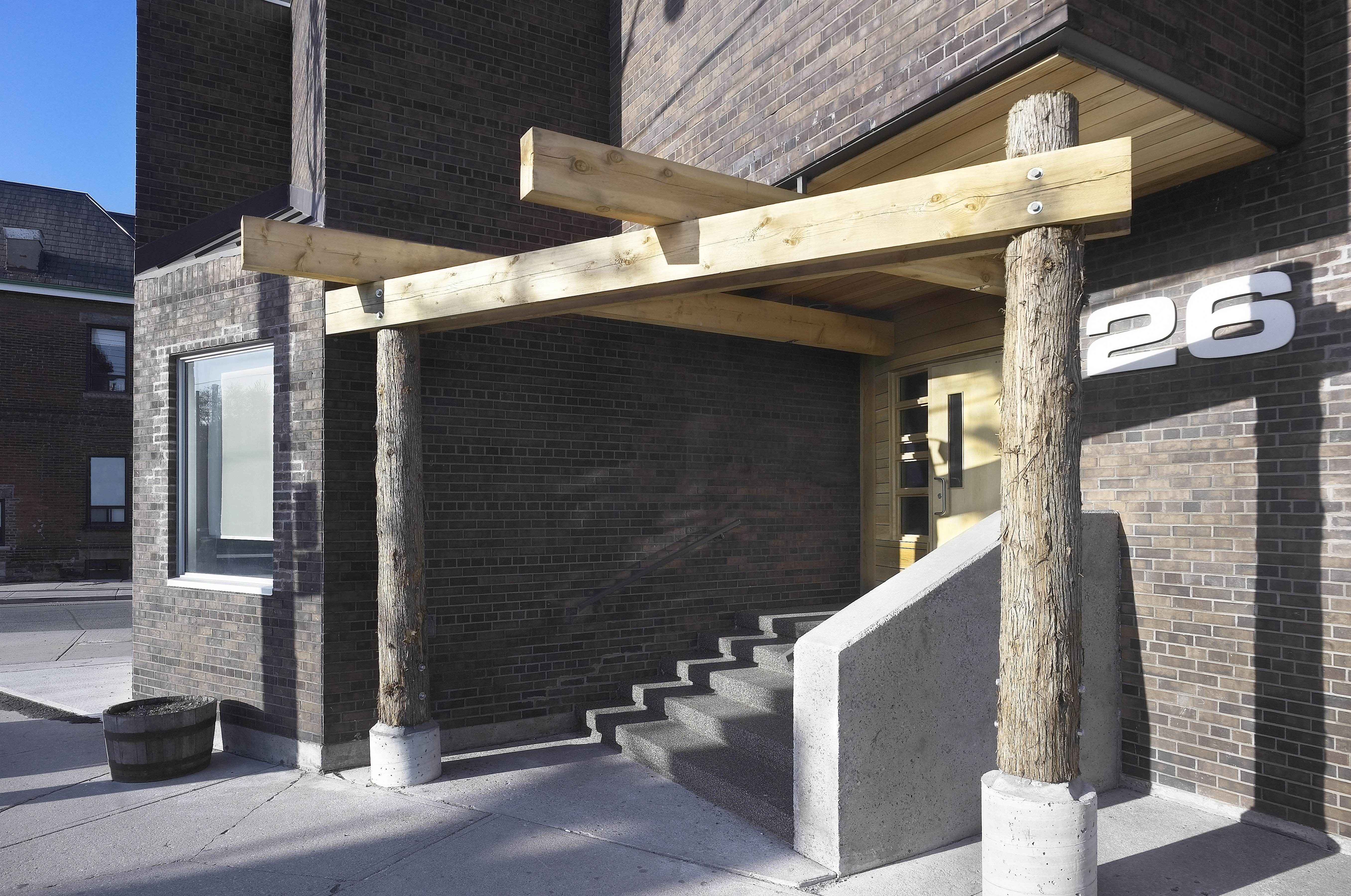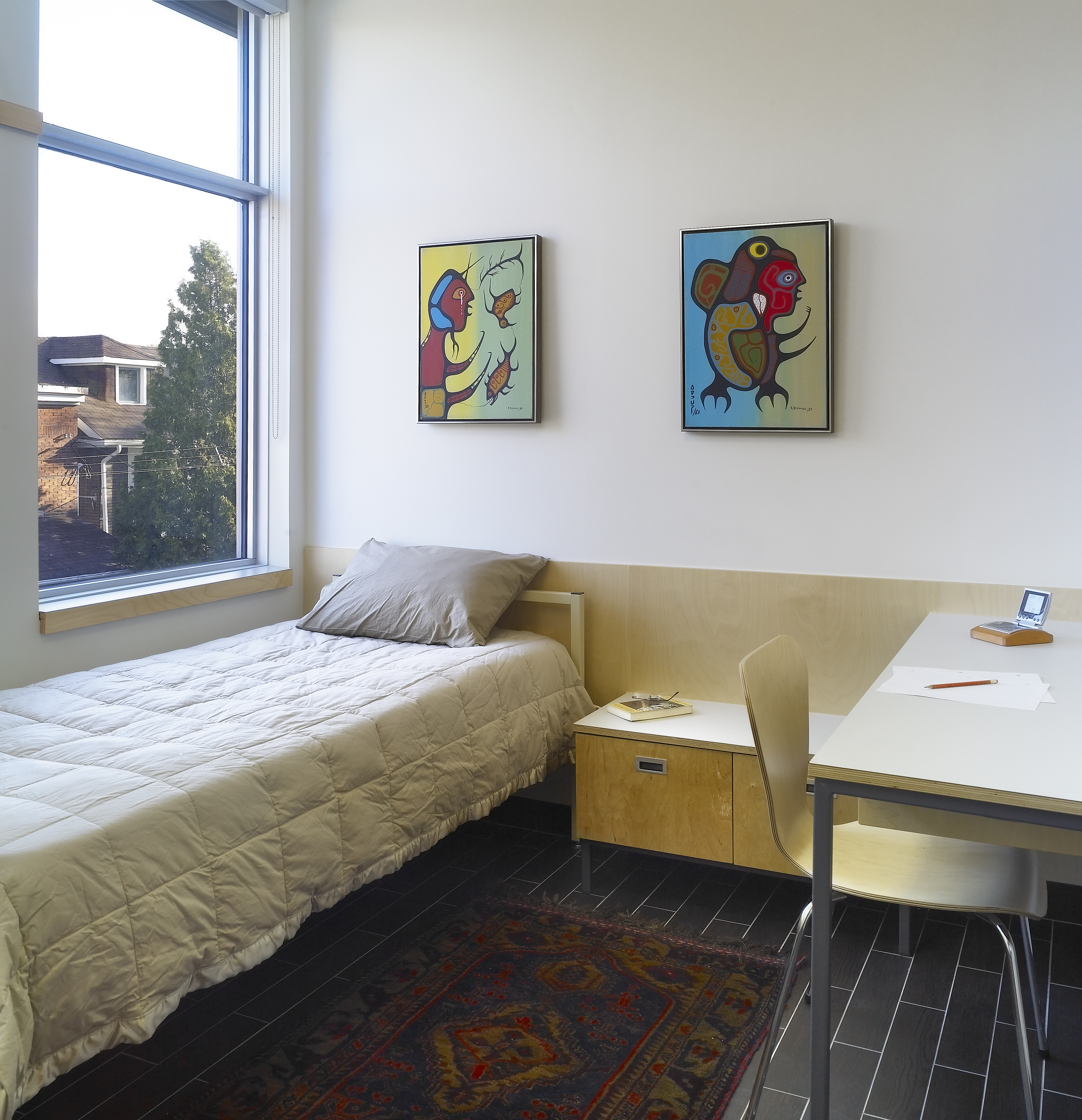Location: Toronto, Ontario
Completed: 2010
Architect: Hilditch Architect Inc.
Nominated by: Jill Andrew, MPP (Toronto—St. Paul's)
Sagatay, meaning “new beginning” in Anishinaabemowin, perfectly describes this transitional housing project that transformed an existing medical building into a safe place to plan the next stage of one’s life—a new beginning for both its residents and the organization behind the project.
A New Beginning
The acquisition of the former medical building located on Vaughan Road—a modest, two-storey structure defined by its sturdy, blocky massing—was a significant and ambitious investment for Na-Me-Res, a charitable organization established in 1985 offering emergency shelter to Toronto-based Indigenous men. The building was an opportunity to deepen the group’s reach and mandate in a meaningful way, but it represented uncharted territory for the organization, which had little experience with this kind of renovation and facility.
In 2002, with the help of Hilditch Architects Inc., Na-Ma-Res reopened the building as the Tumivut Youth Shelter, providing shelter space for 35 youths. But the shelter model and design limitations of the facility proved difficult in fulfilling the organization’s mandate of helping homeless Indigenous men finding their “mino bimaadiziwin,” meaning “a good life.” A re-think was required.
Using what they had learned from the original renovation, Na-Ma-Res and Hidlitch once again worked together to transform the building, opening Sagatay in 2010. Unlike its predecessor, Sagatay is not a shelter but transitional housing project, meaning individuals have their own room and are able to stay during the day. Its focus is also on Indigenous men, the core demographic served by Na-Ma-Res. These characteristics, alongside robust community programs and spaces embedded with cultural significance, have all contributed in making the project a success and model for future projects.
The building and its transformation were a pivotal chapter in Na-Ma-Res’s evolution, equipping the organization with the experience, knowledge, and confidence to develop further housing and support initiatives for Indigenous men.
A Place of Pride, Renewal, and Community
A lesson coming out of the Tumivut Youth Shelter was the importance of embedding Indigenous culture and identity into the project.
The building’s orientation along Vaughan Road—a historic Indigenous trail that cuts diagonally through Toronto’s grid—instantly fosters a deep connection to its surroundings. The east-west alignment honours Indigenous traditions, while logs sourced from the north by the executive director of Na-Me-Res were incorporated into the entrance canopy, extending over the sidewalk as a proud symbol of the building’s Indigenous identity.

Front entrance with logs sourced by the executive director of Sagatay. Image courtesy of Hilditch Architect Inc.
Inside, a carefully crafted wood canopy resembling a canoe on a portage guides a visitor’s journey through the building. The gathering room—featuring elements of earth, water, air, and fire—is the focal point of the facility, providing space for traditional ceremonies, drumming circles, and community meetings. The building even incorporates a sweat lodge— the first of its kind in Toronto and an important space for ceremony and health. The building is filled with artwork designed by some of the shelter’s former residents.
These elements all contribute to a strong sense of identity, helping residents reconnect with their traditions and culture and contributing to Sagatay’s overall success.
Views of wood accents in the interior. Images courtesy of Hilditch Architect Inc.
Designing with Kindness
Another element learned from the shelter system was the importance of designing with empathy and kindness. Extensive consultations with unhoused individuals helped shape the design, ensuring it would meet the diverse needs of those who call it home.
Careful attention was paid to avoid the pitfalls of most institutional settings. For example, instead of being faced by a reception desk with a guard upon entry, residents and visitors to Sagatay are welcomed by the entry sequence of community spaces clad in warm, natural materials. Upstairs, each apartment is completely private, featuring an ensuite washroom and built-in furniture. The architects even considered elements like door closures and locks, conscious it was important for them to feel and sound like those found in a residence rather than an institutional setting.

Interior view of a typical unit. Image courtesy of Hilditch Architect Inc.
The empathy in Sagatay’s design also extends users outside the building to its neighbours and community. The design encourages a sense of openness and accessibility, ensuring that the building feels like a welcoming part of the community, rather than an isolated fortress. The dining room features large sliding glass doors that can open to the street and create a dialogue between Sagatay and the neighbourhood. Today, Na-Me-Res enjoys a close, reciprocal relationship with the local community who view the project as a valuable part of the neighbourhood.
Sagatay is not just a residence; it is a place of pride and renewal for its residents, offering a dignified transition from the shelter system to a more stable future. The building is well-loved and well-used, embodying the philosophy of meeting all stakeholders’ needs with honesty, experience, and a deep respect for the cultural heritage it represents.
This post is part of the OAA’s Queen’s Park Picks 2024 series, where Ontario’s Members of Provincial Parliament (MPPs) were encouraged to nominate a building in their riding for a chance to learn more about it. This year, MPPs were asked to consider various typologies related to housing when making their suggestion, tying into the 2024 OAA Conference theme, Housing: Pushing the Envelope. Check out the rest of the series to learn more about great buildings across the province.